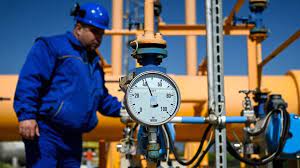The risk of a difficult winter of gas rationing for industries and another surge in energy bills for consumers in Europe just became greater as Russia escalated the gas row with the EU by slashing supply to major customers.
The significantly lower supply from Russia since last week and the upcoming annual maintenance at Nord Stream that will completely halt deliveries through the pipeline for two weeks in July, leaving Europe scrambling to fill gas storage sites to adequate levels before the winter.
It was a race against time to fill storage to 80% even with normal Russian deliveries, but now the race goes further uphill as injections into storage will, at the very least, slow in the coming weeks.
The Russia-Europe gas war sent benchmark European prices soaring by 50% in just one week, and prompted governments in Europe to consider energy-saving measures and a switch to some mothballed coal-fired power capacity to conserve as much gas as possible.
The reduced Russian flows and the outage at the Freeport LNG export terminal in the U.S., which is not expected to return to full operations until late into this year, highlighted Europe’s vulnerable position in procuring gas and filling its gas storage sites in time to prevent a winter of rationing in a few months.
“Our product, our rules.”
Russia claims the gas supply reduction is for “technical reasons” because a gas turbine being repaired in Canada could not be returned in time due to the Western sanctions against Moscow. European leaders, including the prime ministers of Germany and Italy—Russia’s top customers and the ones most heavily affected by the gas supply cuts—said the Russian move to curb deliveries was a political decision and the Russian “technical reasons” were “lies.”
Europe didn’t have to wait for a response from Russia.
“Our product, our rules. We don’t play by rules we didn’t create,” Alexei Miller, the chief executive of Gazprom, said last week about gas supply to Europe.
This message added to existing concerns that Europe cannot rely on Russian supply to fill its gas storage in time for next winter, and governments started announcing measures to conserve energy and gas this summer, even if it means firing up mothballed coal generation plants.
“Red Alert” For EU Gas Supply
Europe faces a “red alert” for gas supply next winter, Fatih Birol, the Executive Director of the International Energy Agency (IEA), said last week.
“Recent disruptions to natural gas supplies, notably Russia steeply cutting flows to EU countries, is set to remove around 35 billion cubic metres of gas from the market this year, posing big challenges to efforts to refill storage. This is a red alert for the EU for next winter,” Birol tweeted on Friday.
Not only is Russia curtailing supply via Nord Stream, it is also refusing to commit to extra capacity via Ukraine. During an auction on Monday, Gazprom did not book additional capacity to ship gas to Europe via Ukraine in July, according to capacity booking results cited by Bloomberg. As a result, gas supply to Europe from Russia will be low for a prolonged period and could dip further if Moscow decides to deepen the curbs in deliveries.
Return To Coal
Faced with low Russian supply, Europe is turning to coal-fired power generation in an effort to replace gas in power generation as it seeks to send gas to storage.
EU member states are now required to reach a minimum 80% gas storage level by November 1 to protect against potential interruptions to supply. In 2023, the target will be raised to 90% full gas storage by November 1.
As of June 20, gas storage in the EU was nearly 55% full, with Germany at 58% full and Italy at 55%, according to data from Gas Infrastructure Europe.
Germany will rely more on electricity generation from coal in order to conserve gas and fill its gas storage by winter, its Economy Minister Robert Habeck said this weekend.
Neighboring Austria plans to convert a reserve gas-fired plant to run on coal, while the Netherlands is set to ease its current restrictions on coal-fired power plants.
Europe’s Storage Filling At Risk
Unless Europe takes additional supply and demand measures, its storage refill this year is at risk, Wood Mackenzie said on Friday.
“If Gazprom continues restricting flows, in both cases storage will runout throughout winter unless other demand or supply measures are taken, or Gazprom sends additional gas via available booked capacity via Ukraine, although we believe this is very unlikely,” said Kateryna Filippenko, principal analyst, global gas research for Wood Mackenzie.
“The situation is evolving rapidly, and Europe may end up in a world without Russian gas sooner than expected and therefore preparations need to start now,” Filippenko noted.
Europe’s race to fill gas storage is driving up benchmark European gas prices and LNG prices, amplifying the global surge in energy prices.

 Iran Energy News Oil, Gas, Petrochemical and Energy Field Specialized Channel
Iran Energy News Oil, Gas, Petrochemical and Energy Field Specialized Channel



